Nuala Ní Chonchúir's Blog, page 9
May 16, 2016
FLORENCE AFTERS
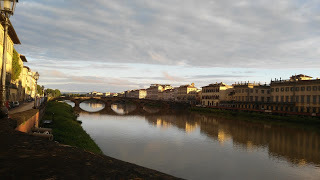 The river Arno from Ponte S. TrinitaI got back yesterday from my trip to Florence for the inaugural Publishing Day run by Florence Writers, an English-language writing group based at St Mark's English Church on Via Maggio, one bridge down from the Ponte Vecchio. It was my first time in the city and I felt instantly comfortable there, the way you do in some places. I often think how you settle in a new place is to do with mood and I was relaxed arriving, so was instantly well disposed.
The river Arno from Ponte S. TrinitaI got back yesterday from my trip to Florence for the inaugural Publishing Day run by Florence Writers, an English-language writing group based at St Mark's English Church on Via Maggio, one bridge down from the Ponte Vecchio. It was my first time in the city and I felt instantly comfortable there, the way you do in some places. I often think how you settle in a new place is to do with mood and I was relaxed arriving, so was instantly well disposed.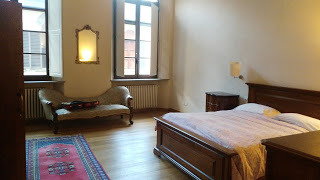 My gorgeous, enormous bedroom
My gorgeous, enormous bedroom
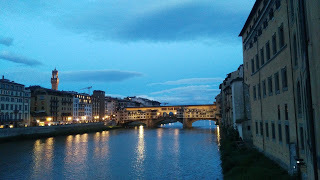 Ponte Vecchio at duskI was met off the airport bus from Pisa by Mundy Walsh, an Irish writer, and admin of St Mark's, who organised the event. She brought me to the lovely apartment above the church that I was to share with another panelist for the weekend.
Ponte Vecchio at duskI was met off the airport bus from Pisa by Mundy Walsh, an Irish writer, and admin of St Mark's, who organised the event. She brought me to the lovely apartment above the church that I was to share with another panelist for the weekend.
I took my 30 year old copy of A Room With a View with me to read. It's a while since I've read it and probably ten years since I watched the film as I only had it on VHS but, oh, oh, oh, it was as fresh and fabulous as ever. I adore E.M. Forster's work and I enjoy this particular novel's reliance on coincidence and overlap, its swipes at snobbishness, and its glorification of art and love. (It wasn't Forster's fave of his books, he considered it 'thin'.) The book is vivid in my memory, so it was comforting to revisit, but I also found it really crisp and funny, as if I was coming at it for the first time. I started to very deliberately slow down my reading so that I would get to spend longer with Lucy, George, Mr Beebe et al. (I want to embark on a major Forster fest now.)
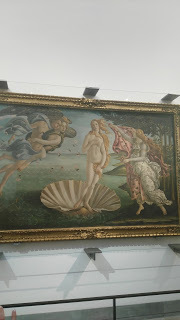 Botticelli's Birth of VenusI had all day Friday to myself before Saturday's day-long event, so of course I was out and about first thing. I went to the Uffizi Gallery to see the Botticellis (in my novel Miss Emily, Emily Dickinson compares her beloved sis-in-law Susan to Venus on her scallop).
Botticelli's Birth of VenusI had all day Friday to myself before Saturday's day-long event, so of course I was out and about first thing. I went to the Uffizi Gallery to see the Botticellis (in my novel Miss Emily, Emily Dickinson compares her beloved sis-in-law Susan to Venus on her scallop).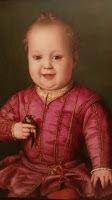
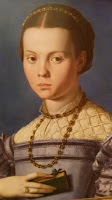
And I also got to see, for the first time, some brilliant Bronzinos. I particularly loved one of a jolly Medici baby and one of a serious young girl with a book.
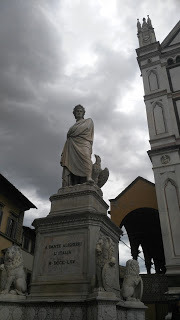 Dante outside Santa Croce
Dante outside Santa Croce
 Santa CroceAfter that I went to Santa Croce (€8 to get in!!) as Lucy and the Emersons go there in A Room With a View, and it is vast, and many-tombed, and impressive. (But we shouldn't have to pay into churches.)
Santa CroceAfter that I went to Santa Croce (€8 to get in!!) as Lucy and the Emersons go there in A Room With a View, and it is vast, and many-tombed, and impressive. (But we shouldn't have to pay into churches.) San Lorenzo marketFlorence was busy, as you can imagine, and also wet - thunderstorms on and off all day. But I dodged a major one by having lunch in the San Lorenzo food market, and another by stopping for hazelnut gelato and what passes for tea on the continent (Lipton's, of course). All the shop and café workers were friendly and patient with my lack of Italian. Lovely, welcoming people.
San Lorenzo marketFlorence was busy, as you can imagine, and also wet - thunderstorms on and off all day. But I dodged a major one by having lunch in the San Lorenzo food market, and another by stopping for hazelnut gelato and what passes for tea on the continent (Lipton's, of course). All the shop and café workers were friendly and patient with my lack of Italian. Lovely, welcoming people.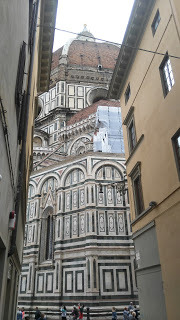 The DuomoI stumbled on the Duomo (glorious!), and spent all day just wandering and marvelling at the endless churches, the noticable lack of tack for sale, the beautiful side streets, the dhal-coloured Arno, the ancient uniformity of all that sandy stone.
The DuomoI stumbled on the Duomo (glorious!), and spent all day just wandering and marvelling at the endless churches, the noticable lack of tack for sale, the beautiful side streets, the dhal-coloured Arno, the ancient uniformity of all that sandy stone.
That evening another of the Publishing Day panelists, Harper Collins UK editor Martha Ashby, arrived and we, guided by Mundy and Lori Hetherington - another organiser of the day - adjourned to nearby Caffè degli Artigiani for aperitivo - pre-dinner drinks and snacks. I had my first taste of Aperol Spritz, a gorgeous mix of bitter orange liquer, prosecco and soda water.
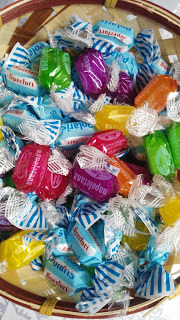 Sweetie fuel for our day :)
Sweetie fuel for our day :)
 Kimberley, Martha and LoriSaturday was work and we had three panels one after the other in the morning in a beautiful room above the church. Martha, myself and two US-based literary agents: Kimberley Cameron and Andrea Cirillo. We talked variously about how to sub your work, what the agent-author relationship is, the use of personal experience in writing, using social media, and how writers can earn. Fuelled by sweeties and water we were ably chaired by three separate writers/editors: Jalina Mhyana, Lisa Clifford and Helen Farrell.
Kimberley, Martha and LoriSaturday was work and we had three panels one after the other in the morning in a beautiful room above the church. Martha, myself and two US-based literary agents: Kimberley Cameron and Andrea Cirillo. We talked variously about how to sub your work, what the agent-author relationship is, the use of personal experience in writing, using social media, and how writers can earn. Fuelled by sweeties and water we were ably chaired by three separate writers/editors: Jalina Mhyana, Lisa Clifford and Helen Farrell. Jalina waiting to beginWe then had ten minute one-to-one sessions with the participants and in the afternoon I hosted an Ask the Author event for all the participants. The writers were a very literate, well-read, knowledgable group and we had some fun and frank discussions about what writers can truly expect out in the literary world, in terms of advances, treatment etc.
Jalina waiting to beginWe then had ten minute one-to-one sessions with the participants and in the afternoon I hosted an Ask the Author event for all the participants. The writers were a very literate, well-read, knowledgable group and we had some fun and frank discussions about what writers can truly expect out in the literary world, in terms of advances, treatment etc. 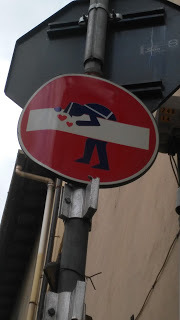 The work of Clet Abraham, graffiti artist
The work of Clet Abraham, graffiti artist
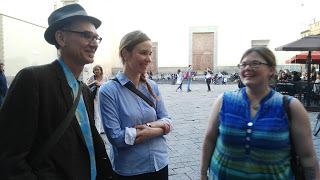 Lee Foust, Mundy Walsh and Kelsey Clifton at Santo Spirito
Lee Foust, Mundy Walsh and Kelsey Clifton at Santo Spirito
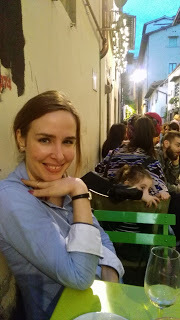 Mundy Walsh of St Mark's and Florence WritersMundy et al laid on a lovely buffet lunch of salads, cheese, bread and strawberries, with salami for the meat-eaters. I went for a swift walk around the Santo Spirito district at lunch time, for the air and headspace, stopping at a local gelateria for a tiramisu.
Mundy Walsh of St Mark's and Florence WritersMundy et al laid on a lovely buffet lunch of salads, cheese, bread and strawberries, with salami for the meat-eaters. I went for a swift walk around the Santo Spirito district at lunch time, for the air and headspace, stopping at a local gelateria for a tiramisu.We had further one-to-ones in the afternoon and later The Florence Writers hosted a prosecco reception for us to wind down after a busy day. Back to Caffè degli Artigiani on Piazza della Passera after that for our aperitivo, with Mundy and American writers Lee Foust and Kelsey C. I loved listening to their stories about how they all ended up in Florence, their knowledge of the language, how often they get home, the things they miss, the things they love in Italy etc. I went home to bed at a sensible hour (sensiblish) as I had an early start for Pisa in the morning and my flight. (I saw the leaning tower from the plane!)
It was a brilliant publishing/writing event, very well organised, which I really appreciate. I met so many great writers with wonderful stories to tell and I was in awe of their spirit, living in this place and learning the language and writing through it all. I loved my time in Florence and was wishing I had more of it, of course. But I will, most definitely be going back.
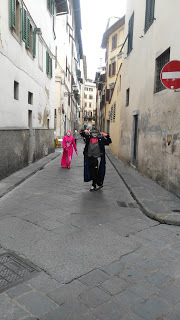 Street performers
Street performers
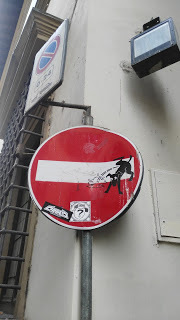 More from Clet
More from Clet
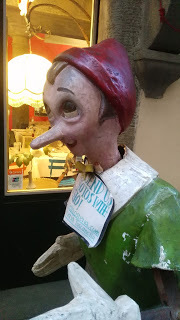 Pinocchio's now a boy...
Pinocchio's now a boy...
Published on May 16, 2016 03:23
May 10, 2016
BOOK SHOW WORD CON
Saturday's Book Show, on RTE Radio 1, is online now here. I was on talking with Sinéad Gleeson, in the company of Bert Wright and Michael O'Loughlin, about WordCon, the forthcoming conference, and writers' rights.
Published on May 10, 2016 06:48
May 6, 2016
GRANTA STORY - 'MAYO OH MAYO'
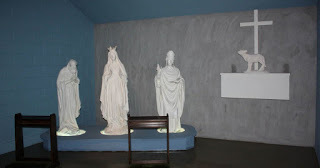 Photograph © Josh HolmesMy short story 'Mayo Oh Mayo' is online at Granta now as part of their Irish issue. Here.
Photograph © Josh HolmesMy short story 'Mayo Oh Mayo' is online at Granta now as part of their Irish issue. Here.
Published on May 06, 2016 01:37
May 3, 2016
THE SHORT STORY INTERVIEW
The Short Story interviews me today. Thanks to Marie Gethins and all the TSS team. It's here.
Published on May 03, 2016 03:43
April 25, 2016
CÚIRT 2016
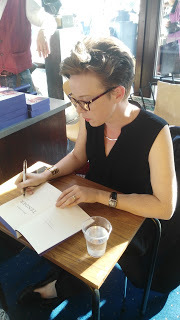 Belinda McKeon signing books at the Town Hall Theatre, GalwayI haven't time to dwell on the usual post-Cúirt deflation as I am on a deadline (Friday!) with novel #4. This is my first round of re-writes for my editor in NY and, oh, it went so well today. I am exhausted after Cúirt but a good night's sleep had me right on track this morning. There is nothing quite like the high when the writing goes well, when the questions posed can be answered (and Tara, my ed, asks good questions). I even forgot about lunch which anyone who knows me will realise is UNBELIEVABLE.
Belinda McKeon signing books at the Town Hall Theatre, GalwayI haven't time to dwell on the usual post-Cúirt deflation as I am on a deadline (Friday!) with novel #4. This is my first round of re-writes for my editor in NY and, oh, it went so well today. I am exhausted after Cúirt but a good night's sleep had me right on track this morning. There is nothing quite like the high when the writing goes well, when the questions posed can be answered (and Tara, my ed, asks good questions). I even forgot about lunch which anyone who knows me will realise is UNBELIEVABLE.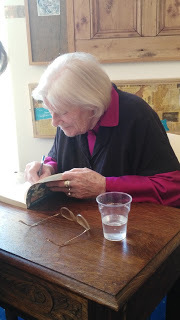 Jennifer Johnston signing books at the Town Hall Theatre, GalwayCúirt was fantastic, as ever. I had the privilege of interviewing writers Jennifer Johnston and Belinda McKeon together. I hope that at 86 I am still writing, still publishing, as Jennifer is. Her 18th novel, Naming the Stars, appears in June. She read from it, and Belinda read from Tender (that hilarious scene where the young Catherine interviews An Older Irish Male Writer), and both were brilliant.
Jennifer Johnston signing books at the Town Hall Theatre, GalwayCúirt was fantastic, as ever. I had the privilege of interviewing writers Jennifer Johnston and Belinda McKeon together. I hope that at 86 I am still writing, still publishing, as Jennifer is. Her 18th novel, Naming the Stars, appears in June. She read from it, and Belinda read from Tender (that hilarious scene where the young Catherine interviews An Older Irish Male Writer), and both were brilliant.We talked about yearning, discomfort and language in fiction, as well as autobiography, parents and POV characters (male vs female main protagonists). We spoke about growing up as regards character development and parental hobbling in Jennifer's novel. We talked about the Irish writer's obligation when it comes to The Troubles in Northern Ireland. Both writers had plenty of interesting things to say and, really, an hour was far too short a spell to spend with them. We could've yammered on and on. If I loved both women before, I love them even more now.
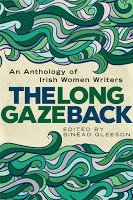
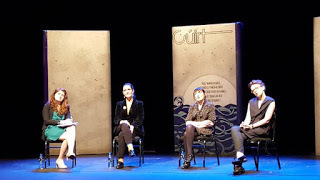 Long Gaze panel - pic by Majella O'DeaI also took part in a panel discussion based around The Long Gaze Back anthology with its editor Sinéad Gleeson, Belinda McKeon and Cúirt director Dani Gill. We covered lots of topics: #ReadWomen, the importance of networking, mentors and champions, the need to keep the gender conversation in literature wide and ongoing, the importance of mutual support for women writers (giving back), the Baileys Prize and more.
Long Gaze panel - pic by Majella O'DeaI also took part in a panel discussion based around The Long Gaze Back anthology with its editor Sinéad Gleeson, Belinda McKeon and Cúirt director Dani Gill. We covered lots of topics: #ReadWomen, the importance of networking, mentors and champions, the need to keep the gender conversation in literature wide and ongoing, the importance of mutual support for women writers (giving back), the Baileys Prize and more.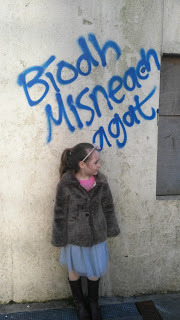 Juno with Prospect Hill graffiti - Irish for 'Take courage'
Juno with Prospect Hill graffiti - Irish for 'Take courage'
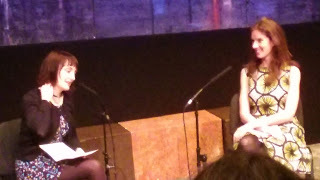 A pretty poor pic of Sinéad Gleeson & Leslie JamisonIn terms of attending events for pleasure, I managed to hear several fantastic writers, including Leslie Jamison, Kirsty Logan, Miriam Toews and Joanna Walsh. There was a wonderful chiming of themes discussed, all things I am super-interested in: grief, memory, mental illness, and 'truth' in fiction. My mind was racing with thoughts and ideas (and admiration) after each reading/discussion. And I bought books, lots of lovely books, from Charlie Byrne's wide selection.
A pretty poor pic of Sinéad Gleeson & Leslie JamisonIn terms of attending events for pleasure, I managed to hear several fantastic writers, including Leslie Jamison, Kirsty Logan, Miriam Toews and Joanna Walsh. There was a wonderful chiming of themes discussed, all things I am super-interested in: grief, memory, mental illness, and 'truth' in fiction. My mind was racing with thoughts and ideas (and admiration) after each reading/discussion. And I bought books, lots of lovely books, from Charlie Byrne's wide selection.On the social side, I had lunch, tea, wine, din-dins and fun with plenty of wondrous people including Sinéad Gleeson, Belinda McKeon, Joanna Walsh, Lisa McInerney (she of the Baileys Prize shortlisting - woot!), super-successful YA writer Louise O'Neill, Tom Morris of the Stinging Fly, Declan Meade of the same parish, New York-based writer Joshua Ferris, my Smokelong pal Chris Allen and his partner. It was all very jolly and exhausting. We even managed a spin out to Salthill and Barna to eat ginormous fruit salads and bagels, and be mesmerised by the sea. As we drove back in by the Claddagh, I was reminded of why I moved to Galway twenty years go - it really is a magical place.
Published on April 25, 2016 08:41
April 20, 2016
KATHLEEN GRISSOM'S TOP 14 HISTORICAL NOVELS
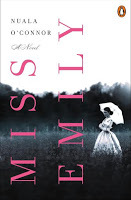
Kathleen Grissom, author of The Kitchen House, has included Miss Emily in her top 14 historical novels at Off the Shelf. Which is rather lovely. The list contains lots of book to add to the TBR pile. See here.
Published on April 20, 2016 01:32
April 18, 2016
MISS EMILY REVIEW AT DBR
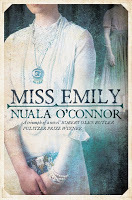
Writer Adam Wyeth has given Miss Emily a beautiful review in this essay at the Dublin Review of Books. I am posting it in full here in case it disappears from their site.
THE THING WITH FEATHERSAdam Wyeth
Miss Emily, by Nuala O’Connor, Sandstone Press, 350 pp, €8.99, ISBN: 978-1910124550Nuala O’Connor’s novel Miss Emily is more than a portrait of a poet executed with exquisite precision. It offers a fresh, enhancing approach to Dickinson’s inner life, showing a woman with zest and independence of mind.One of the big mysteries that continues to dog Emily Dickinson critics and biographers is why one of America’s foremost poets spent most of her time indoors, never married and indeed hardly left her childhood home till the day she died? Was she depressed, agoraphobic or bipolar? While there is no conclusive evidence that she suffered from any such condition, this hasn’t stopped critics from drawing a myriad of conclusions. While speculation is well and good, the level of scrutiny and diagnoses in recent years has often tended to be reductive, taking from the work and the poet herself. So it is refreshing that in Nuala O’Connor’s meticulously honed new novel Miss Emily the story avoids any labels and instead offers a fresh, enhancing approach to Dickinson’s inner life – showing a woman with zest and independence of mind and an artist absorbed in her work and art.This is not to say that Miss Emily doesn’t explore deeper and darker aspects. Everything in the novel is touched with a darkness that recoils and simmers under the surface of everyday life. While Miss Emily is fiction, O’Connor’s research on the poet is extensive and we get a strong sense of Dickinson’s true personality. Enthusiasts will recognise many poetical strands and biographical titbits woven into the narrative. As an accomplished poet herself, O’Connor is well versed in metaphor and telling the truth slant. Indeed it is her lyrical gift at skilfully lifting daily domestic activities into something almost mythical, rich with resonance and suggestion that makes Miss Emily such an engrossing read.The novel opens in Amherst, Massachusetts. Homestead, the Dickinson family home, is in disarray after their long-term Irish maid has left to create a family of her own. The smell of burnt potatoes presages another Irish maid to follow. Each chapter alternates between Emily Dickinson and her maid-to-be Ada Concannon. We first meet Ada, on a sunny day in June, aged seventeen, soaking herself in the river Liffey, against her parents’ wishes. The bucolic image linked to the river goddess is the first of many interlaced mythological symbols. The river also signals a longer journey to follow across the water to the New World.Despite the upstairs-downstairs scenario, Emily and Ada immediately strike up a close friendship, both sharing a sense of mischief and a love of baking. Although the American poet and Irish maid may appear to be poles apart the dual point of view creates some intriguing parallels and insights. Dickinson describes Ada as having, “a superior, petulant face, but when she smiles, she glows like a window opening on a bright day. I want to make her smile.” Does the final line offer a slight hint of something else desired, as well as friendship? The hidden suggestion also extends to the intimate relationship Dickinson has with her sister-in-law. Miss Emily loves to spend time with Ada and says how she admires the Irish, “ … how they spin a narrative around every small thing. I feel somewhat Irish in my core.” However, Emily’s brother Austin is less enamoured of Ada and offers the more common prejudicial attitude towards the Irish. “Do not be fooled by her mellifluousness — all Irish people lie … You have to understand that there is a certain island madness about the Irish; they are unhinged and vicious.”At times the intimate friendship and psychological drama that unfolds have intimations of a Strindberg play. In fact, Strindberg’s similarly titled haunting masterpiece Miss Julie takes place in one domestic setting, mostly in the kitchen – as does Miss Emily – between the lady of the house and her servant. No doubt the author is more than aware of this relation and the similar title is a nod in the play’s direction.It takes a writer of keen perception to portray and capture a life in a whole novel within a confined setting; O’Connor does so with remarkable tenacity and panache. Her sheer relish for rendering nineteenth century American domestic life and her gift for finding the mot juste brings the Dickinson home to life. “I am in the habit of this house, and it is in the habit of me,” Dickinson says. Homestead becomes almost a character itself. In Freudian analysis the home is a symbol of the self. Thus every item and room of the house can be seen as a different part of the poet’s psyche.Exquisitely detailed descriptions of home care and cooking ripple and steam off every page. Every domestic moment is magnified with the crisp artistry of a Vermeer painting. But the level of intense, sensory detail displays more than just atmosphere. As well as conveying Dickinson’s intense and piercing perception, each description lends itself to an ever-deepening tapestry of patterns and symbolism, revealing the darker emotions and unconscious stirrings beneath. The zoom lens clarity and visual storytelling become a superb and subtle plot device foreshadowing traumatic events to come. Moreover, like so many period dramas, it is the stiff-collared, hemmed-in Puritanism that makes each scene all the more tantalising, as when Ada puts her lips to her admirer, Daniel’s, cup, to “drink back the lukewarm dregs of his tea”. As much as O’Connor does an assured job for capturing the language of the period, she avoids getting entangled in any antiquated purple prose. The carefully selected concrete details within descriptions are poetry enough.This bright window into Dickinson’s private world also offers many insights into her poetical development. A key moment is when Dickinson decides to wear only white. “My very whiteness will be my muse,” she says. It acts as the foundation of her poetic vocation, much like an actor embodying the character in a play when he or she puts on the costume. She is born again. “Like a revenant,” her mother remarks. Rather than seeing Dickinson’s sartorial decision as some mental infliction, O’Connor shows it as a moment of artistic epiphany, turning Dickinson’s desire for crisp white clothing as a moment of metamorphosis. It is as if she has turned herself into a clean white page. Such epiphanic moments are well recorded with many major writers. For Synge, it was when he was encouraged by Yeats to go and live among the people of the west of Ireland, to learn their language and write about their ways. For Beckett it was the decision to write in French that allowed him to purify his prose and move out of Joyce’s overbearing shadow.Instead of getting caught up in the impossible task of diagnosing the poet as having a mental illness, critics might be equally attentive of the mad world she retreated from. No man is an island, but all artists need to withdraw from the world to create their work. “Hope is the thing with feathers” is one of Dickinson’s most famous lines. It is that delicate, elusive thing in her work that continues to inspire succeeding generations. Executed with exquisite precision, Miss Emily is more than a portrait of a poet. Like a Dickinson poem itself, it is a rare bird of radiant plumage darting through the air, striking and transcendental but impossible to pin down.
Published on April 18, 2016 01:25
April 14, 2016
UPCOMING EVENTS
I am busy with novel re-writes for my lovely editor so haven't much time for blogging. News soon on that front :)
In the meantime, here's a round up of some of my upcoming events. Hope to say hi to some of you at them.
Fly on the Wall, DublinI'm taking part in a panel about class as part of The Stinging Fly’s Fly on the Wall sessions.
With Sean O’Reilly, Niall Griffiths, Jon McGregor, and Lisa McInerney who has just been shortlisted for the Bailey's Prize.16th April, 4pm – Project Arts Centre
Cork World Book FestNext Wednesday I will read from Miss Emily, with Rob Doyle, in Cork City Library.
20th April at 8.30pmMore here.
Cúirt International Festival of Literature, GalwayI will moderate a reading and interview at Cúirt with writers Belinda McKeon and Jennifer Johnston.Saturday 23rd April, Town Hall Theatre, 4.30pm.
I will also read and take part in a conversation at Cúirt about The Long Gaze Back anthology with Belinda McKeon, Sinead Gleeson and Dani Gill. Sunday 24th April, Town Hall Theatre, 2pm.
Waterford Writers WeekendI will be on a panel on the short story at Waterford Writers Weekend, with Tom Morris, Sinéad Gleeson and Orla Shanaghy.Friday, 6 May 2016, 7pm, Waterford Central Library
Publishing Day, Florence, ItalyI am taking part in a publishing day at St Mark’s in Florence, Italy.14th May, 9am to 6pmMore info here.
Words Ireland Literature Conference, DublinI will be on a panel about writers’ pay and conditions at the inaugural National Literature Conference19th May 2016, National Library, Kildare street, Dublin 2.9.45am - 4.45pm
In the meantime, here's a round up of some of my upcoming events. Hope to say hi to some of you at them.
Fly on the Wall, DublinI'm taking part in a panel about class as part of The Stinging Fly’s Fly on the Wall sessions.
With Sean O’Reilly, Niall Griffiths, Jon McGregor, and Lisa McInerney who has just been shortlisted for the Bailey's Prize.16th April, 4pm – Project Arts Centre
Cork World Book FestNext Wednesday I will read from Miss Emily, with Rob Doyle, in Cork City Library.
20th April at 8.30pmMore here.
Cúirt International Festival of Literature, GalwayI will moderate a reading and interview at Cúirt with writers Belinda McKeon and Jennifer Johnston.Saturday 23rd April, Town Hall Theatre, 4.30pm.
I will also read and take part in a conversation at Cúirt about The Long Gaze Back anthology with Belinda McKeon, Sinead Gleeson and Dani Gill. Sunday 24th April, Town Hall Theatre, 2pm.
Waterford Writers WeekendI will be on a panel on the short story at Waterford Writers Weekend, with Tom Morris, Sinéad Gleeson and Orla Shanaghy.Friday, 6 May 2016, 7pm, Waterford Central Library
Publishing Day, Florence, ItalyI am taking part in a publishing day at St Mark’s in Florence, Italy.14th May, 9am to 6pmMore info here.
Words Ireland Literature Conference, DublinI will be on a panel about writers’ pay and conditions at the inaugural National Literature Conference19th May 2016, National Library, Kildare street, Dublin 2.9.45am - 4.45pm
Published on April 14, 2016 08:44
April 5, 2016
BOOK SHOW - HIST FIC ON SOUNDCLOUD & A REVIEW
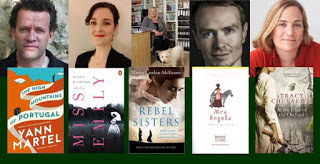
I've been under the weather for the past month and so have not been able to do much lately. But the broadcast of the Book Show, where I discussed historical fiction with Gavin McCrea, Marita Conlon McKenna and Sinéad Gleeson, is now on Soundcloud here. Tracy Chevalier and Yann Martel feature either side of our discussion.
*
Journalist Darragh McManus reviewed our Book Show chat in the Independent, last Sunday, here. Below is what he had to say about us (and himself!):
'Staying with books and (sort of) the past, The Book Show (Radio 1, Sat 7pm) looked at novels based on real people. Host Sinéad Gleeson was joined in studio by three Irish writers "whose work is set in the past and whose novels also blend fiction and history".
Nuala O'Connor's Miss Emily is about the poet Emily Dickinson; Gavin McCrea's Mrs Engels concerns the relationship between Frederick Engels and two sisters; Marita Conlon-McKenna's latest novel, Rebel Sisters, tells an invented tale about a real event: the aforementioned Easter Rising.Now, I have a bit of a problem with fiction based on fact. It often strikes me as a sort of lazy short-cut to creativity, ie you don't need to invent the character/characters: they already exist, in history.Also, it irks me no end when writers - not these ones, I hasten to add - use and exploit real-life tragedies for their own cynical, monetary ends. You know what I mean, all those books about the Holocaust, or inspired by actual horrors like the Fritzel case: they know this ghoulish stuff sells to a rubbernecking audience.However, O'Connor, McCrea and Conlon-McKenna get a pass from the McManus Jury because a) their books are set in the distant past, a century or more, and that makes a significant difference; b) these works aren't exploitative in a Holocaust porn/Fritzel case kind of way; and c) having listened to them describe the process, I realise there is an incredible amount of work involved in writing a book like this.All that research - how do they do it? You couldn't pay me to write a historical novel. Granted, nobody wants to pay me to write a historical novel, either, but you get my point.'
Published on April 05, 2016 03:13
March 23, 2016
MISS EMILY LONGLISTED IN MM BENNETTS HIST FIC AWARD
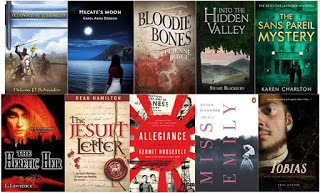
Miss Emily is on the longlist of nine books in the MM Bennetts Award for Historical Fiction. Here's the list:
Helena P. Schrader – Defender of Jerusalem
Carol Anne Dobson – Hecate’s Moon
Lucienne Boyce: Bloodie Bones
Stuart Blackburn: Into the Hidden Valley
Karen Charlton: The San Pareil Mystery
Prue Batten: Tobias
Gemma Lawrence: The Heretic Heir
Dean Hamilton: The Jesuit Letter
Kermit Roosevelt: Allegiance
Nuala O’Connor: Miss EmilyThe finalists will be announced in May. Big congrats to my fellow nominees!
Published on March 23, 2016 04:46
Nuala Ní Chonchúir's Blog
- Nuala Ní Chonchúir's profile
- 41 followers
Nuala Ní Chonchúir isn't a Goodreads Author
(yet),
but they
do have a blog,
so here are some recent posts imported from
their feed.



